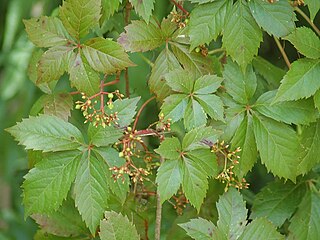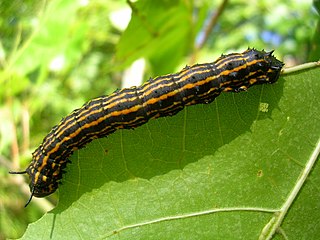
Anisota senatoria, the orangestriped oakworm, is a Nearctic member of the family Saturniidae and subfamily Ceratocampinae. It is one of the more common Saturniids, reaching pest status occasionally in the northern parts of its range. As they are late-season feeders, however, they do little lasting damage to their hosts. It is very similar to A. finlaysoni in southern Ontario and A. peigleri in the southern US. The species was first described by James Edward Smith in 1797.
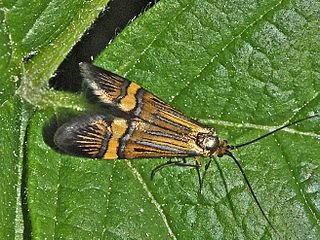
The longhorn moth or yellow-barred long-horn is a diurnal lepidopteran from the moths family Adelidae.

Acleris variegana, the garden rose tortricid moth or fruit tortricid, is a moth of the family Tortricidae. It has a Palaearctic distribution. The moth flies from July to September mainly at night and is attracted to bright lights. The larvae feed on various trees and shrubs including rose and apple.

Haploa clymene is a moth of the tiger moth subfamily - Arctiinae, tribe Arctiini. It is found in eastern North America.

Hemaris thetis, the Rocky Mountain clearwing or California clearwing, is a moth of the family Sphingidae. The species was first described by Jean Baptiste Boisduval in 1855. It is found from Colorado, New Mexico, Montana, Idaho, Wyoming and Utah west to California and north to British Columbia. The habitat consists of streamsides and meadows in mountainous areas.
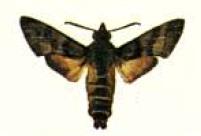
Cephonodes trochilus is a moth of the family Sphingidae. It is known from Mauritius.
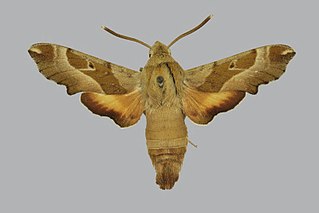
Proserpinus gaurae, the proud sphinx moth, is a moth of the family Sphingidae. The species was first described by James Edward Smith in 1797. It is found from Texas and Louisiana east to northern Florida, north to Alabama, Missouri, northern Georgia and South Carolina. It may range as far south as northern Mexico.
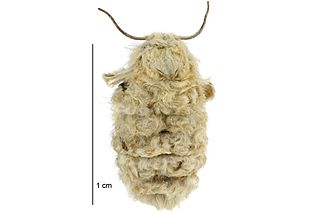
Metacrias erichrysa is a species of moth of the family Erebidae. It is endemic to New Zealand. This species can be found in the lower half of the North Island and western alpine areas of the South Island. The female of the species is flightless and buff coloured whereas the male is brightly coloured and a rapid flier.
Paraclemensia acerifoliella, the maple leafcutter moth, is a moth of the Incurvariidae family. It is found from south-eastern Canada and the north-eastern United States, south to the tip of the Appalachian Mountains in western North Carolina and possibly north-western Georgia.
Satyrium behrii, the Behr's hairstreak, is a butterfly of the family Lycaenidae. It is found in western North America from western Texas north and west through New Mexico, Arizona, and southern California to British Columbia.
Adela eldorada is a moth of the Adelidae family or fairy longhorn moths. It was described by Powell in 1969. It is found from Washington to California.
Adela flammeusella is a moth of the family Adelidae or fairy longhorn moths. It was described by Vactor Tousey Chambers in 1876. It is found in the United States from southern Washington south to the foothills and interior valleys of most of cismontane California.
Adela oplerella is a species of moth of the family Adelidae, the fairy longhorn moths. It is known commonly as Opler's longhorn moth. It is endemic to California.
Adela septentrionella is a moth of the family Adelidae or fairy longhorn moths. It was described by Walsingham in 1880. It is widespread from southern British Columbia and north-western Idaho to the Transverse Range in southern California.
Adela singulella is a moth of the family Adelidae or fairy longhorn moths. It was described by Walsingham in 1880. It is found in California, where it is known from southern Mendocino, Napa and northern Marin Counties. It is also found on the west slope of the Sierra Nevada from El Dorado to Kern County, in the Coast Ranges of Santa Clara County southward, to San Luis Obispo County and then into the San Gabriel Mountains.

Adela trigrapha is a moth of the family Adelidae or fairy longhorn moths. It was described by Zeller in 1876. It is found in western North America, from Vancouver Island to California.
Dicymolomia opuntialis is a moth in the family Crambidae. It is found in North America, where it has been recorded from California.
Elachista cucullata is a moth of the family Elachistidae. It is found in North America, where it has been recorded from California, Florida, Indiana, Maine, Massachusetts, Mississippi, New Jersey, New Mexico, Ohio, Ontario, Pennsylvania, Quebec and West Virginia.

Uresiphita reversalis, the genista broom moth or sophora worm, is a moth in the Crambidae family. It was described by Achille Guenée in 1854. It is found in North America, where it has been recorded from Nova Scotia to Florida, west to California, north to Colorado, Nebraska and Iowa It is also found in Mexico and Cuba, Bermuda, Puerto Rico and Jamaica.

Proxenus miranda, the miranda moth or glistening rustic, is a moth of the family Noctuidae. It is found in most of North America, where it has been recorded south through California to Arizona and in the Rocky Mountains to Colorado in the west. In the east it is found from southern Canada to South Carolina, Tennessee and Texas. The habitat consists of moist, open forests and grasslands.



